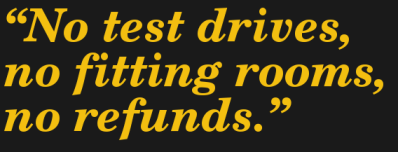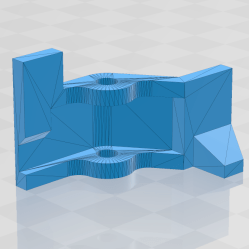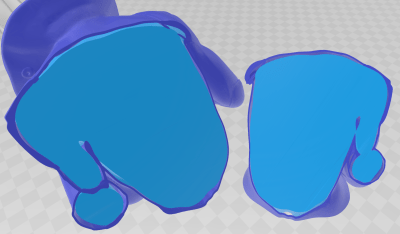There are more free 3D models online than one can shake a stick at, but what about paid models? Hosting models somewhere and putting a buy button in front of the download is certainly a solved problem, but after spending some time buying and printing a variety of non-free 3D models online, it’s clear that there are shortcomings in the current system.
What the problems are and how to address them depends a little on the different ways models get sold, but one thing is clear: poorly-designed 3D models are bad for consumers, and bad for the future of pay-to-download in general.
Different Ways Models Get Sold
There are quite a few different ways 3D models get sold online. Online sales are great for digital models because models are not physical goods, and serving a thousand buyers is no different from serving ten. A user technically pays for a license to use the model rather than purchasing it outright, and terms vary depending on the creators and providers.
 Direct Sales (Pay per Model)
Direct Sales (Pay per Model)
Direct sales work just like free 3D models, but with a price tag stuck in front of the download. Sites like Cults3D and MyMiniFactory allow creators to set prices on non-free models. Sales numbers are a bit hard to determine, but popular models have hundreds or a few thousand downloads.
A standout success is a site like Hero Forge, which allows users to create custom tabletop gaming miniatures with a web-based interface. Users can pay to download the STL of their creation, or pay for a printed version. Hero Forge is a proprietary system, but a highly successful one judging by their recent Kickstarter campaign.
Indirect Sales (Pay for Access to Models)
Indirect selling is when customers pay for access, rather than buying models individually. Successful creators make models in a niche area of interest, and people pay for ongoing access to the creator’s library of work.
Patreon is a common way for 3D model creators to manage monthly subscribers and provide access to files. Tabletop gaming is a common niche, and some of the bigger players have thousands of monthly subscribers.
Another way indirect sales are done is via crowdfunding campaign. Money is raised to create a specific set of models, and backers receive access to the resulting files. Again, tabletop gaming miniatures and terrain are over-represented in this area.
Kits Where Customers Print Their Own Parts
This approach sells 3D models as part of a product. Sold with or without additional hardware like electrical parts or fasteners, a purchaser buys a kit and prints their own plastic parts. As a result, the kit has fewer pieces, is easier to produce, cheaper to ship, and generally costs less than if the seller had to provide everything.
Examples of this business model include the (NERF-compatible) Bulwark Blaster, and the OpenScan (open-source 3D scanner.) In both cases, the project is built around 3D-printed parts and a solid bill of materials. Generally, the buyer is purchasing a single-use license for the printed parts.
Where Are The Problems?
In an ideal world, 3D printers reliably create any arbitrary shape without having issues with overhangs, bridges, distortions, or supports. One could purchase a 3D model and get exactly what’s expected. Sadly, we’re not there yet.
Good-quality 3D models must be designed specifically for 3D printing, and this is especially true if money is involved because in the current system, buyers accept all the risk.
No Test Drives, No Fitting Rooms, No Refunds
The world of non-free 3D models is a lot like a clothing store without a fitting room, or a showroom without test drives. “No refunds” is a common term of service and sale, and when combined with an inability to try before one buys, results can be unfortunate if a model is of poor quality.
Models With Poor DFM (Design for Manufacture) Exist
3D printers, like any tool, are good at some things, passable at others, and bad at the rest. That means models intended for 3D printing should be designed with the strengths and weaknesses of 3D printers in mind. A model that has been designed in such a way can be said to have good design for manufacture (DFM).

If a model has not been designed with 3D printing in mind, it can make life difficult for the person trying to print it. The trouble is that it’s not always possible to identify troublesome models by screenshots alone. Here are two examples.
The first is a simple latch from a larger assembly intended for FDM (filament-based) printing, shown here. The problem is subtle: the way it has been designed makes it virtually impossible to print reliably without needing supports, no matter the orientation. (It also had other problems, but more on that later.)
Adding supports means additional post-processing and a poor surface finish where the supports connect. If supports are placed on the latch’s presentation side, the part will be ugly. If supports go on a non-presentation side (where the hinge is) it invites fitment problems.
These issues can be solved with post-processing, but that’s not the point. The point is that it would be better to design the part in a way that avoids such problems in the first place.

Another example is shown here. This model was advertised as being compatible with SLA (resin-based) printing. FDM and SLA printers are good at very different things, so it was encouraging to see a model specifically designed for SLA.
Unfortunately this turned out to not be the case. The model was not a solid figure. There are gaps between the outer layer (the figure’s jacket) and inner layer (the body) because they were modeled separately, and left as-is.
Not only do these gaps trap uncured resin, but the areas around the gaps are very thin, which invites print failures. In short, this model’s design choices ensure that the outside layers — the presentation surfaces — are the most likely to fail. These issues were not visible until after the model was paid for.
These problems and others like them demonstrate poor DFM that is not evident from screenshots and renders, and as mentioned earlier, pay-to-download is currently the land of No Refunds and Buyer Beware.
Why Bad Quality Models Are A Big Problem

The problem bad models cause is this: by the time a model has proven to be troublesome (or impossible, or wasteful) to print, a buyer has invested considerably more than the purchase price. All a bad model accomplishes is to alienate a person who was willing to mash a BUY button.
Having a buyer accept all the risk, only to have their expense of money and effort rendered worthless should be considered a worst-case scenario for any platform that is trying to grow.
Ways To Improve
It may be tempting to try to solve the issue of no returns or refunds with a system that can control access to downloaded files, but anything in this direction starts to look a lot like DRM, which is doubtful as a way forward.
It is possible to increase confidence about model quality and purchase without changing much about the underlying platforms as they currently exist. Here are some things that can be done.
Demonstrate Model Quality with Photos and Documentation
Documentation and photos (of the printed results, not just renders of the model) are an effective way to let a buyer know more about a model. Documentation doesn’t have to be long, but it should talk about design elements, assembly, or areas of special attention. An example is this model of a 3D printable vise by Christophe Laimer. It’s a free model, but excellent documentation in a way that builds confidence in the model’s quality.
Models that require additional hardware should have a clear bill of materials along with specifications and sources. That latch model I used as an example of poor DFM? It required a mystery spring of unspecified dimensions and no source; another issue not discovered until too late.
If a designer doesn’t clearly demonstrate that they have printed their own design successfully, don’t buy it.
Provide “Test Drive” Pieces
Designers of kits or other assemblies for sale can offer free access to small number of parts as a way of saying “if you can print these models and assemble them, you’re good to go because my product is designed using the same principles.” If customers cannot return purchases, this can at least provide a form of test drive.
Perform Automatic Quality Checks on Models
Professional print places like 3D Hubs perform an analysis of uploaded objects as part of their quote process, and warn about model features like thin walls, intricate details that could be lost, or the potential for hard-to-remove supports. Services responsible for hosting and selling models could increase buyer confidence by performing similar checks on models for sale, and showing the analysis along with the model and price.
What is Your Experience With Paid Models?
Have you bought models online, or do you sell your own designs? What’s been your experience, and what would you change about how it all works? Let us know your feelings in the comments.
No comments:
Post a Comment